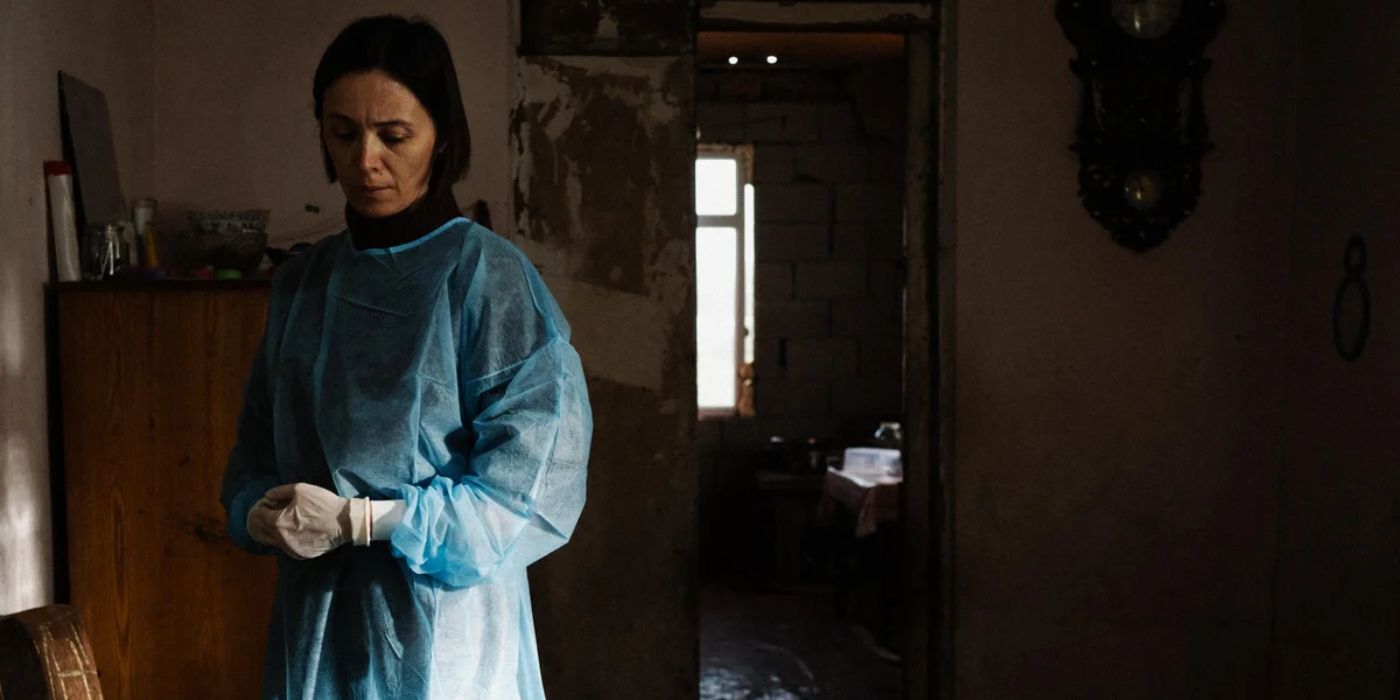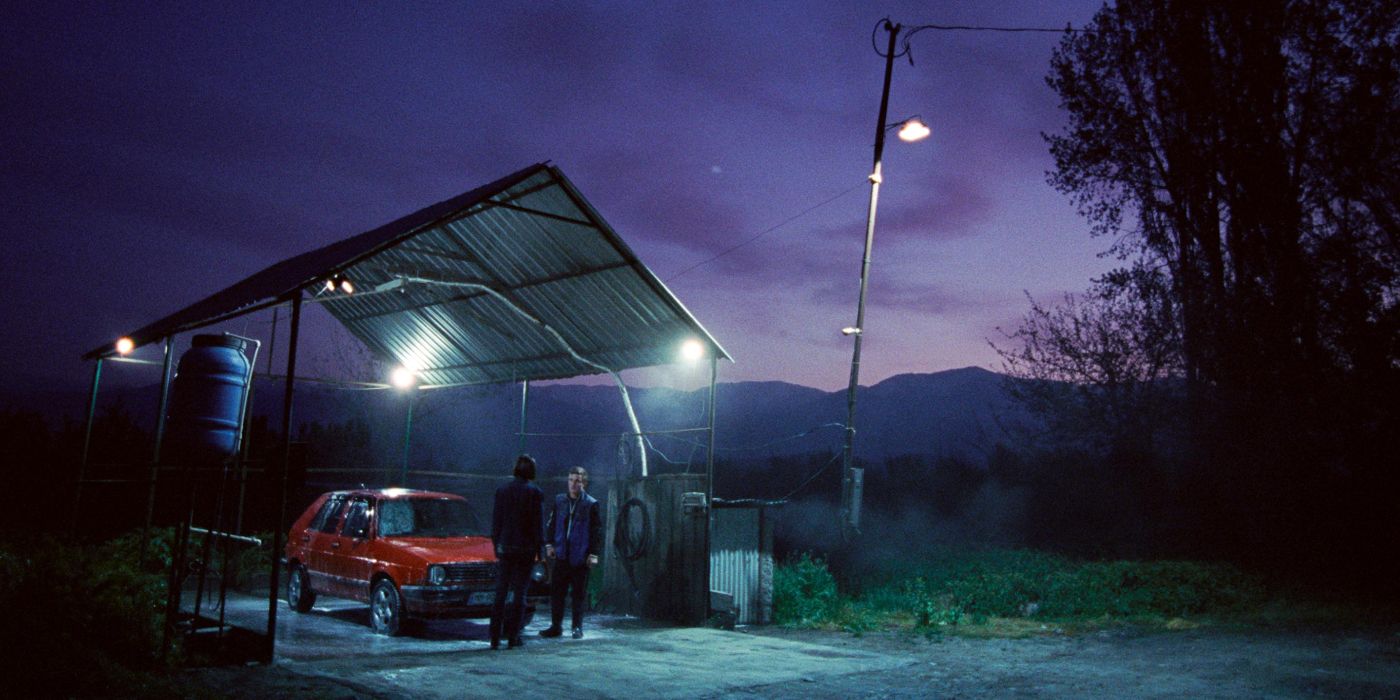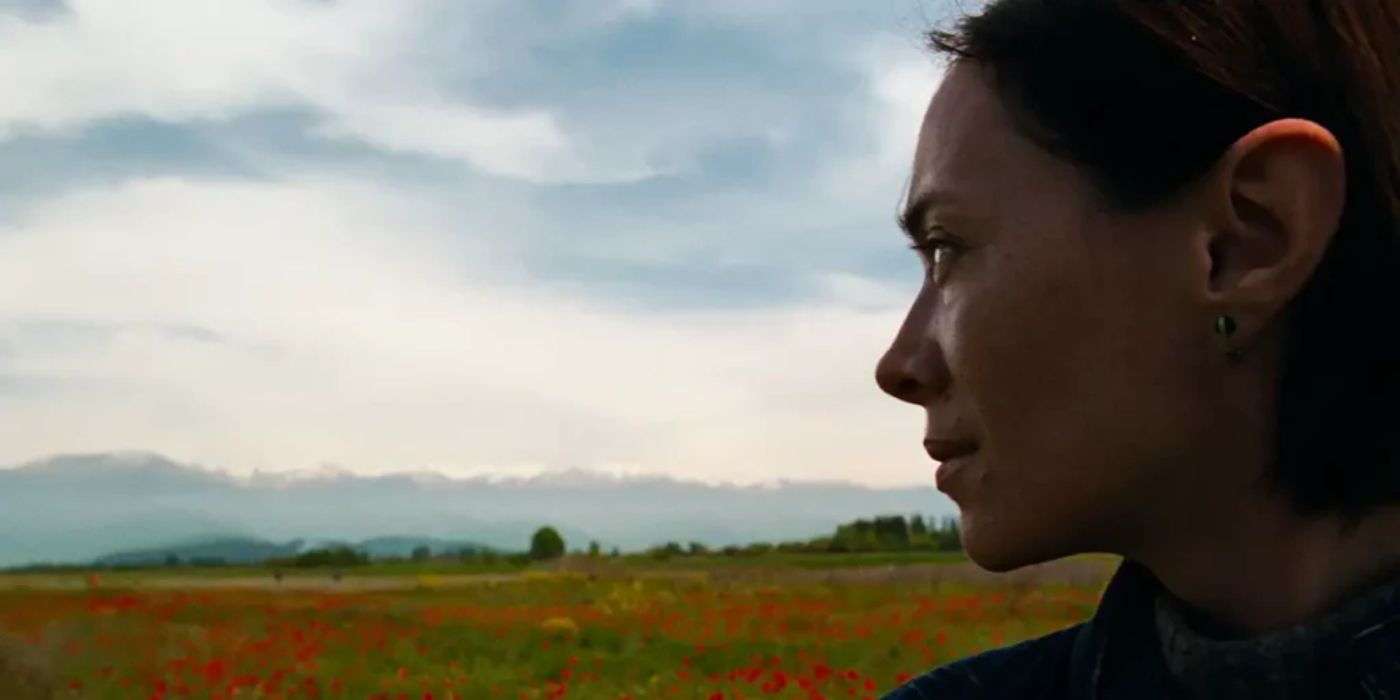
Dea Kulumbegashvili’s second film, titled “April“, is a profoundly contemplative piece that invites viewers to grapple with its tense pauses and thought-provoking queries. The story revolves around Nina (Ia Sukhitashvili), a Georgia-based OB-GYN who finds herself in a challenging predicament as her private and professional lives intertwine due to her quiet resistance against the nation’s laws restricting abortions.
In my opinion, “April” is an extraordinary exploration into a character’s soul, effortlessly transcending traditional storytelling boundaries. It masterfully employs a cinematic language that feels tangible, immersive, and strikingly intimate. With intricate, layered editing, methodical pacing, and enveloping soundscapes, Kulumbegashvili creates an atmosphere that is as unsettling as it is profoundly human. At its heart, this film delves deep into the complexities of a woman’s existence in a deeply traditional Georgian society where gender roles are heavily influenced by generational norms and community values. It also examines the heavy moral and emotional burdens that come with living in systems that seek to control and monitor them. As an admirer, I found it both challenging and incredibly humanizing.
The Enigmatic Figure: Innocence Lost and Reclaimed
In April, we find ourselves in a place that feels both familiar and elusive. An elderly, gender-neutral figure appears here and there, their presence somewhat unsettling yet oddly captivating. Kulumbegashvili skillfully places us within the realm of the uncanny, contrasting this eerie figure with the tranquility of the ambient sounds. The cheerful laughter of children echoes through the soundscape, intermingling with the gentle tapping of raindrops. The camera focuses on a still puddle mirroring a purple sky, its calmness starkly contrasting with the excited voices of children calling out, “Nina.
Initially, these components seem scattered and disjointed, akin to an intentionally unfinished puzzle. However, when the movie transitions into a powerful wide shot of a young woman in labor, the strands of sound, visuals, and meaning start coming together. The labor scene is portrayed with raw authenticity, as Kulumbegashvili’s camera steadfastly focuses on the gripping reality of childbirth. It is during this moment that we are introduced to Nina, not as the woman in labor or the nurse offering sugary words like “good girl,” but as the doctor, calm and composed amidst the turmoil surrounding her.
In the following scene, Nina encounters three individuals: her superior doctor (Merab Ninidze), David (Kakha Kintscurashvili), and the new father (Sandro Kalandadze) of the woman who has just delivered a baby. While her chief physician is solely focused on preserving the hospital’s image for the community, he pays no attention to Nina’s welfare. On the other hand, David pretends to be concerned about Nina with his words, while the husband harbors intense anger towards her, symbolizing the oppressive cultural and patriarchal norms that she struggles against.
During this crucial conversation, the movie’s main dispute arises when the man accuses Nina of illegally performing abortions in nearby villages, calling her a murderer. His words are filled with malice, but it is his final action – spitting contemptuously at her – that disrupts the delicate balance. The camera maintains an impassive and unyielding distance, mirroring Nina’s own demeanor, and records not only the man’s animosity but also Nina’s subdued reaction, a mask that we, as viewers, cannot yet fully penetrate.
Layered Observations and Sonic Immersion

In this unadorned setting, we find the character, Nina, bare and alone within her home, with the curtains drawn. The raw emotion of her vulnerability is strongly felt, starkly contrasting the reserved demeanor she displays at the hospital. Kulumbegashvili’s camera work intentionally avoids offering solace to the viewer. Instead, it underscores Nina’s detachment from her surroundings — a woman who bears the burden of others’ opinions, aspirations, and moral standards, even as she struggles with her own. Though Nina serves as our main character, the filmmaker, April, deliberately refrains from portraying her in a manner that elicits immediate empathy.
The story unfolds piece by piece, providing insights into the protagonist’s life in an order that breaks traditional narrative patterns. Details are given sparingly and sometimes out of sequence, requiring viewers to actively piece together the storyline. Kulumbegashvili uses a method of detailed, observational editing to immerse the audience more deeply into Nina’s perspective. The film maintains long, continuous shots, giving us time to contemplate alongside Nina as she witnesses a scene, before abruptly switching to her viewpoint, disclosing additional details.
The sequence follows a pattern similar to our real-life experiences: initially observing events from an outsider’s perspective, then becoming involved, and eventually dealing with the emotional and situational repercussions of what has transpired. This editing method generates a disconcerting feeling of temporal flexibility, as time and comprehension progress piece by piece. This requires patience and contemplation from viewers. It’s a design decision that echoes the unforgiving world Nina lives in, where her silent rebellion is met with scrutiny and dismissal. However, amidst this fractured tale, there are instances of profound insight that expose the extent of Nina’s solitude and strength.
In another poignant instance, as Nina departs from a disrespectful fellow villager, she casts her eyes into a deserted livestock train. Within lies a frail mother cow nursing her weak and undernourished calf – evidently pregnant again. The likeness is undeniable: a being trapped in endless reproduction, its autonomy taken away by powers it can’t grasp. Nina remains, powerless to help, her eyes mirroring the helplessness she feels in her own existence. This chilling tableau lingers in one’s mind long after it vanishes from sight.
The Rebirth and Restraints of Spring

The title April symbolically represents the spring season, encompassing themes of renewal, transformation, yet also uncertainty. This contrast is mirrored in the movie’s visuals: the picturesque beauty of nature, the puddles reflecting the showers of spring rain, and the mud that burdens both the ground and Nina in her personal circumstances. In essence, it hints at the film’s examination of life cycles and the limited control experienced by many women, much like how one can’t command the elements or the factors influencing their reality.
In a subtle yet revealing turn, characters who seem supportive towards Nina, such as David, are found to be unknowingly contributing to the very societal norms that restrict her. For instance, David’s initial kindness toward Nina transforms into condescension when he subtly implies that she should reconsider her stance on abortion by having a child. His words are tinged with paternalistic concern as he nostalgically talks about his wife and children, implying that Nina lacks fulfillment without motherhood. This interaction is striking because David, blinded by self-importance, overlooks Nina’s silent resistance to his perspective. The narrative invites us, the audience, to peer beneath the surface of human interactions and contemplate whether these relationships support or stifle each other.
The Rosy Red of Rebellion
Kulumbegashvili’s visual style underscores a request for self-examination. In one instance, an office is crafted so intricately it evokes an Alice Neel painting, with its shadows and silence urging the spectator to look beyond the surface for deeper meaning. The camera seldom shifts position, but when it does, it unveils additional information with a sense of intentionality that feels both deliberate and deserved. This is particularly noticeable in Nina’s exchanges with her patients – women who struggle to express the systemic violence that has molded their lives yet yearn for something greater.
A 16-year-old girl, sporting red-painted fingernails, aspires to complete her education, but her family pressures her to forego her dreams to start a family. Throughout the movie, the color red is subtly yet significantly used, symbolizing liberty and self-determination. It serves as a visual motif that links Nina with other women, each of them trapped under similar oppressive norms and yearning for freedom in their own quiet ways. This is a recurring theme visually tying Nina to these women, all of whom are subjected to the same confining expectations and searching for a means of escape.
In one of the movie’s most poignant scenes, I found myself witnessing a moment that echoed with profound symbolism. As Mzia (Ana Nikolava), a mother in distress, implores me, Nina, to carry out an abortion on her silent, teenage daughter, she unwittingly exposes the hidden truth of their situation. This truth, veiled until now, becomes clear to me and to those who have been attentive to the story thus far.
The director, Kulumbegashvili, chooses not to delve into the technicalities of the abortion, instead opting to focus on Mzia’s hands, gripping her daughter tightly, filled with fear and anxiety. When the deed is done, Mzia’s hand, adorned with red-painted nails, is shown – a seemingly insignificant moment that carries immense weight and encapsulates the film’s core message.
In this silent act of defiance, of liberation, a semblance of freedom is granted, however temporary it may be. This scene, quiet yet powerful, beautifully encapsulates the essence of the movie.
Nina’s Affirmation of Autonomy and Identity in ‘April’
In the movie, it’s clear that Dr. Nina possesses influence that transcends her professional life. One particularly impactful scene showcases Nina’s hidden longings as she waits at a car wash. A timid young man, clearly uneasy around her, rushes to quickly wash her vehicle. When he exits the frame, his car is seen in a bright red color. Silently, Nina beckons him, and they venture into the woods together. The camera stops tracking them, but their power dynamic is evident. Nina takes charge, and the man complies with her wishes – an unusual event in a setting where male dominance is typically unchallenged and assumed.
In another close interaction with a new individual, Nina maintains the same commanding presence. When he inquires about her life, she feels no obligation and reveals only select details – a poignant recollection from her childhood that holds deep regret: her sister nearly drowning while playing in the rain, a memory Nina can’t pardon herself for. This moment showcases her raw emotional honesty, yet underscores her determination not to be shaped by the preconceived notions others may have of her. Nina’s independence isn’t limited to the physical realm, but extends to her emotions and psychological state as well. The longing that David and others express for her is insignificant compared to what Nina truly seeks: power – not power for its own sake, but the ability to control her own life and choices.
A Cinematic Demand for Introspection
The interplay of power, guilt, and rebellion forms the heart of Nina’s character as well as Kulumbegashvili’s artistic perspective. Every decision Nina makes, every quiet act of resistance, helps her reclaim a fragment of the identity she was compelled to abandon. As the movie subtly returns to its initial scenes, the genderless figure and children’s laughter hold fresh significance. They aren’t mere recollections—they serve as the cornerstone of Nina’s new identity, the life she has constructed from the remnants of her past.
April, both in its narrative and its creation, serves as a remarkable demonstration of cinematic defiance. In a society where individuals like Nina are frequently expected to surrender their bodies, expressions, and essence to external forces, Kulumbegashvili’s relentless camera resists looking away. This is a movie that necessitates understanding and exposure from its viewers, offering a rich reward for those who immerse themselves in its subtle, heart-wrenching intensity. As the closing credits unfold and the lingering sounds of children’s joy fade, what lingers is an intense sense of urgency – a prompt to scrutinize the systems that govern us and to envision, despite oppression, what it signifies to be free.
In late January and early February, the film titled “April” will be shown again. Specifically, it’s set to screen on January 29th and February 2nd. For more details about the screening times and other information, please visit this link.
Read More
- Grimguard Tactics tier list – Ranking the main classes
- 10 Most Anticipated Anime of 2025
- USD CNY PREDICTION
- Silver Rate Forecast
- Box Office: ‘Jurassic World Rebirth’ Stomping to $127M U.S. Bow, North of $250M Million Globally
- Gold Rate Forecast
- Black Myth: Wukong minimum & recommended system requirements for PC
- Mech Vs Aliens codes – Currently active promos (June 2025)
- Maiden Academy tier list
- Hero Tale best builds – One for melee, one for ranged characters
2025-04-02 19:40